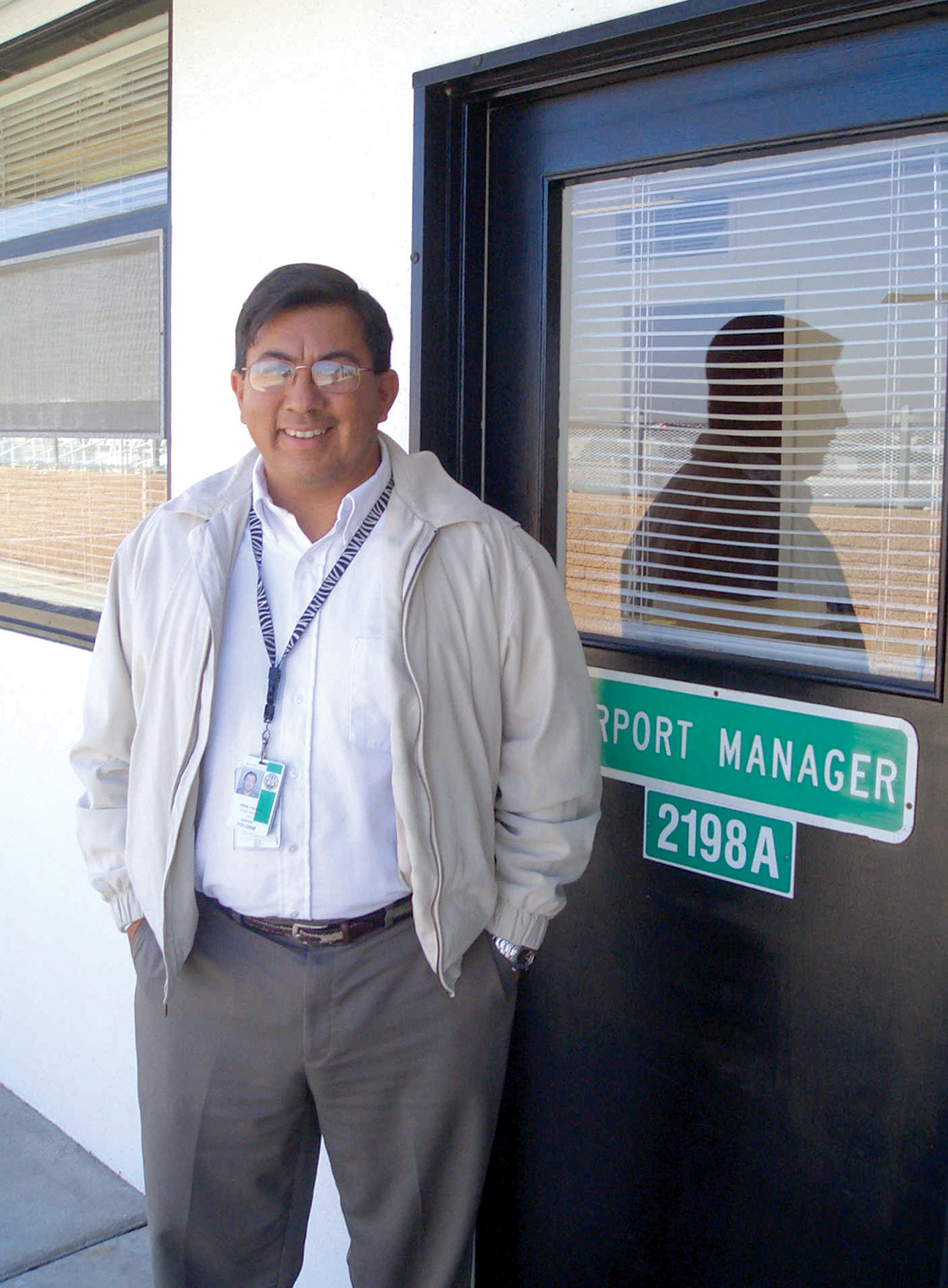By Patty Kovacevich,
A cultural landmark is carving a new modern edge into the San Diego skyline. Palomar-McClellan Airport, in Carlsbad, Calif., is upgrading itself with a first class “extreme makeover,” as worldwide travel demands more streamlined jet travel.
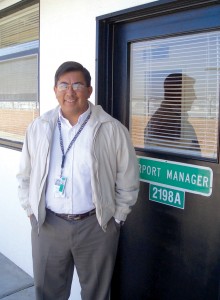
Willy Vasquez, GM of Palomar-McClellan Airport, passes through the doors of time. His modular office soon will be torn down and rebuilt for Palomar’s “total airport makeover.”
Owned by the County of San Diego, and located in North County, Palomar Airport (CRQ) is getting on in years, and this 60+ year old is now due to undergo a facelift. With the explosive development and growth that has occurred north of main town San Diego, it’s time to shape up the looks and technology at Palomar as the market shift north is occurring faster than a Learjet on takeoff.
Palomar Airport’s rich history is the talk of long-time locals who share the memories most residents don’t even know about. From an almost bygone era, Palomar is preparing for many big changes, with the resulting growth in air traffic that will inevitably occur.
For over 60 years Palomar has been the general aviation airport for small aircraft owners and pilots. In 1956, the county bought the 250-acre site to help boost economic development in North County. Three years later, in 1959, the airport was built. Some of the original buildings still stand today, reminding us of an earlier, simpler time.
About 40 private airplanes and one pioneer commercial carrier, Bonanza Airlines, initially used Palomar. Local poinsettia growers were among the first businesses to use it for its quick and convenient air delivery service of fresh flowers to the East Coast. Those buildings of old–a modular unit group that make up the present day terminal, a dated restaurant with creaking floors, and a parking lot that floods when it rains–are all being torn down now to make way for a new, more glamorous, more efficient Palomar.
Palomar is growing with its strategic location, welcoming private planes, corporate jets, and increased commercial commuter flights. The past six years especially have seen corporate executives and other VIPs being whisked away on their private corporate jets or pricey commercial commuters as North County travelers become too impatient to wait in line at bigger airports.
You can’t hold back the hands of Father Time. He’s always marching forward and Palomar must now keep in step.
“The airport has some very exciting changes ahead,” declares Willy Vazquez, Palomar’s new general manager.
Vazquez became GM at Palomar in October 2005, after previously managing nearby Ramona Airport (RNM). With over 22 years in aviation, Vazquez knows a thing or two about airport safety and operation issues. In between various management positions he took on special major airport projects and served as a relief pitcher for specific tasks at hand at various other airports in the San Diego area. Vazquez is the only staff airport management member who has personally inspected every single hangar and office in all eight county airports. The task took him years to complete.
Palomar Grows Up
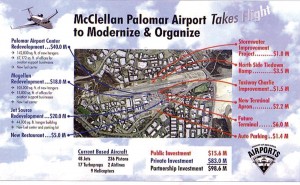
A McClellan-Palomar Airport renovation projection chart shows a completely new and modernized airport is soon on the horizon.
In earlier days at Palomar, pilots and friends tooled around in a small weekend Cessna. The glittering future has landed. Upscale homes and high-end businesses reflect the explosive population of San Diego. Corporations want their own plane and high net worth individuals like Bill Gates are deciding San Diego is the place to live and Palomar is the airport for getting into and out of the area.
Commercial air travel today makes up only a very small percentage of operational services at Palomar. Currently United Express & Sky West Express service travelers, but only to and from Los Angeles and Phoenix daily. Those commercial airlines intend to stay, with no others presently in the offing for Palomar. Increased interest may change all that as Las Vegas becomes more in demand from charters and San Diego residents want a quick and easy commercial air travel ease to the gambling Mecca.
“We handled 208,000 airport operations in 2005,” Vazquez reported. “Of that grand total, general aviation flights made up 83.7 percent, compared with business and corporate flights totaling 14 percent, and commercial flights, 3 percent.”
Along with community growth and expansion of any nature comes dissention. Some GA pilots and small-business owners aren’t pleased with Palomar’s growth. Some small aircraft pilots are feeling displaced in favor of the corporate jets while others are elated to move Palomar into future growth positioning.
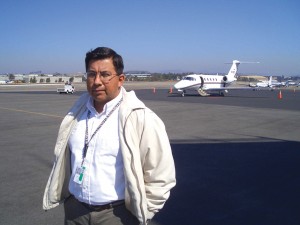
Willy Vazquez on tarmac with jet in background: Willy Vazquez got his aviation start in aircraft safety maintenance.
“We’ve got to modernize and still keep smaller GA service and community residents as happy as possible,” Vazquez said. “We’re currently completing the building of 134 tie-down spots on the north end of the airport for smaller aircraft. It’s a $2 million county project. We sincerely want to help out everyone as progress moves forward.”
United States Customs is coming also to Palomar, a huge forward move. This is expected to ease total travel time since the present day stop off is at Montgomery Field (MYF). US Customs won’t be free at Palomar, however, like it is at Montgomery. Oddly, the customs push is actually being driven in large part by the private fixed base operations at Palomar and their customer base decidedly wanting the convenience, even at a cost.
“We’ve been told a U.S. Customs station at Palomar will mean greater service and better use of valuable time for the corporate charter and private business clients who report that they’ll gladly pay for the time convenience,” Vazquez said.
Some community residents fear a new customs stopover will bring more traffic and noise, thus some town outcry is being heard against the measure.
“Our estimates see a balance. We don’t believe there will actually be any increase of traffic and noise,” Vazquez said. “Our estimates are that it’ll all balance itself out since Montgomery costs money and Palomar customs will be at an extra fee to the flyer. Not everyone will want to pay that extra customs fee.”
Environmental concerns cry for attention
To modernize and organize, the airport has progress on one side of the scale and growth pains and environmental issues on the other. Solar taxiway lights and solar parking lights will be included to add some “green,” bringing welcomed, progressive environmental touches to the multimillion dollar face-lift.
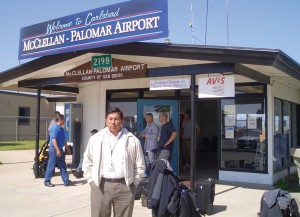
The days are numbered for Palomar-McClellan Airport. A new, cutting-edge, high-tech airport terminal will soon replace the airport’s 60-year-old modular building passenger terminal.
Noise study programs and airport meetings carefully have reviewed the noise abatement needs. A blast fence at the north end of Taxiway Alpha is projected since some of the larger jets run up their engines and highway traffic is close by. Community committees and subcommittees are established to address noise abatement and environmental concerns, and to address community complaints and requests of any nature. And these committees aren’t just aviation aficionados, according to Vazquez. No stonewalling here. Residents and businesses are encouraged to utilize the airport’s outreach.
With a 24/7 airport, the FAA also has final say on a lot of issues. The tower is presently not open 24/7, but the airport is. And residents and businesses are encouraged to utilize the airport’s outreach to hear their cries.
Private airport contributions are anticipated to total $98 million, with around $40 million from Premier Aviation, $20 million from Jet Source, $18 million from Magellan Aviation, and a new restaurant providing an additional $5 million in revenue. Public investments are projected to total $15.6 million, with a $1 million oil separator storm water improvement, a $3.5 million north side tie-down ramp, a Taxiway Charlie improvement of $1.5 million, new terminal apron at $2.2 million, a future terminal at $6 million and a new parking lot coming at $1.4 million.
“The large storm water improvement development, which is part of the tie-down development, will include the ability to capture all the water that comes from the airport as it heads north. We’re going to capture all the water and run it through clarifiers before it leaves the airport to make sure it’s extra clean. It will be free of oils and sediments and such, and therefore much healthier for the environment,” Vazquez proudly adds.
A new $2.2 million Taxiway Charlie apron will be the main access to and from a new ramp, along with a $6 million, 10,000-square-foot, two-story new terminal project. Anticipated completion is 2007.
Funding is secured for the renovation from the county, the FAA and bond money. San Diego’s city financial woes are separate. There’ll be no crying wolf from the city. Like a military flight mission, there’s no turning back.
The entire Palomar Airport expansion will spell growth for the corporate and residential community and vice versa. It’s a bit like a growing family. With expansion comes much good, and also challenge. As we have often heard before, one thing in life is certain: change. Seems change is true in the life of airports also.
For more information about McClellan-Palomar Airport, visit [http://www.co.san-diego.ca.us/dpw/airports/mcpal.htm].











